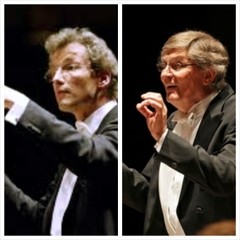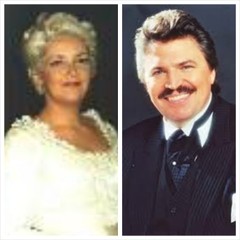|
Back
An Ode to Deficiency New York
Isaac Stern Auditorium, Carnegie Hall
02/25/2014 -
Arnold Schoenberg: Friede auf Erden, Opus 13
Ludwig van Beethoven: Symphony No. 9 in D Minor (“Choral”), Opus 125
Ricarda Merbeth (Soprano), Zorvana Kushpler (Mezzo-soprano), Peter Seiffert (Tenor), Günther Groissböck (Bass)
New York Choral Artists, Joseph Flummerfelt (Chorus Director), Vienna Philharmonic Orchestra, Franz Welser-Möst (Conductor)

F. Welser-Möst, J. Flummerfelt (©Roger Mastroianni/William Strubs)
In a perfect world, last night’s concert would have started like this. The splendid New York Choral Artists, under Joseph Flummerfelt, would have sung that rarest of Schoenberg choral works, Peace n Earth without any orchestra as it was originally written, behind the silent Vienna Philharmonic Orchestra on stage.
At the end of the fortissimo D Major chord (the only purely harmonic chord in the entire nine minutes), the audience would be stunned into silence, Maestro Franz Welser-Möst would have raised his baton, and the mysterious opening of the Beethoven Ninth Symphony would have floated downwards to the deep, a singular transition with an original alliance of music. The result could have been an ode to mysticism.
This, though, is not a perfect world, and the evening, while a treat for the Great and the Good who were in the audience, missed by a long shot its potential transcendence.
For one thing, Schoenberg’s Friede auf Erden used the orchestral setting which Schoenberg had advised only for those choruses having difficulty with the intonation. With most choruses, that would be right. I had never heard the piece before yesterday morning, but the score (on YouTube) showed a chorus enduring unlikely jumps, chromatic dissonances, momentary divisions of the voices, and, until the last chord, an exceedingly difficult not-quite-atonal work.
The New York Choral Artists could easily have mastered its intricacies, so the addition of an orchestra to its already Gordian knots of music became clotted with extraneous notes. At times (forgive me) it was like one of those bloated Elgar choral pieces written around the same time, in 1907. A shame, that this wonderful work at its New York premiere, should get such an unworthy treatment.
Instead of the perfect segue (“Peace on Earth” to “Hymn of Joy”), a few minutes went by for the full orchestra to get on stage. But at least, I thought, Franz Welser-Möst might give a splendid performances. Yet again disappointment. A Ninth Symphony which, except for one movement, was clamorous and often sloppy.
Possibly this was because the Maestro of the Cleveland Orchestra was a last-minute replacement for the ailing Danielle Gatti. Another conductor might have taken the orchestra though its usual soaring paces, but Mr. Welser-Möst not only decided to put his own stamp on the Vienna Philharmonic, but is such a perfectionist that the orchestra could have been intimidated.
I can’t think of any other reason why the first movement began with a bang instead of a cosmic whisper, and why the scherzo was merely fast, without contour, without anything even approaching the Titanic laughter of the composer. Throughout both sections, the woodwinds were slurred, the brass simply loud, and the strings...well, nobody can defeat the Vienna Phil string section.
The Maestro not only made amends during the third movement, but he turned musical tragedy into a momentary triumph. Mr. Welser-Möst never attempted an Adagio molto, but started off at a comfortable Andante pace, with a cantabile showing off how the Vienna Phil can really play. Nothing dragged here, it was lyrical, touching, even at times transcendent, making up for the first two movements.

R. Merbeth, P. Seiffert (© Anton Schaupp/Vienna Philharmonic)
Something unsettling happened during the finale. In a way, this movement moves itself. Get some good soloists, a good choir, a good pace, and Shazam!, you have the Ninth at its best.
Well, Mr. Welser-Möst had the orchestra and choir, but where were the soloists? The chairs were empty, the orchestra began its reprise, and no soloists appeared. I imagined this might be the Grammy’s, and the quartet might come swinging down from the balconies, waving and kissing to the audience.
Instead–and far worse–the four soloists strolled onto the stage in the middle of the movement, like a pair of Kansas City visitors who had used the wrong door and wandered onto the Carnegie Hall stage, deciding to sit down to rest their weary buttocks after a hard day of shopping.
(More skeptically, I assumed the divas simply didn’t want to sit around while that silly orchestra was playing.)
Whatever it was, the opera divas sung the Beethoven like it was an opera, and certainly not the mystic, mysterious alliance which the composer actually felt with his Spiritual Universe. Günther Groissböck has a stentorian voice, but those immortal words, ”O Freunde” erupted like Wotan berating the gods. Peter Seiffert’s tenor was brilliant, yet one couldn’t help thinking that his “Joy, through the glorious order of heaven” snapped and barked like a prison guard at his inmates.
The two women, soprano Ricarda Merbeth and mezzo Zorvana Kushpler, were far more into the symphonic structure of the movement. And the New York Choral Artists sung their hearts out with the orchestra.
The ending was, as always, pretty glorious. But such glory last night was all too much like a second-hand rainbow blurred as a reflection on a muddy body of water.
Harry Rolnick
|